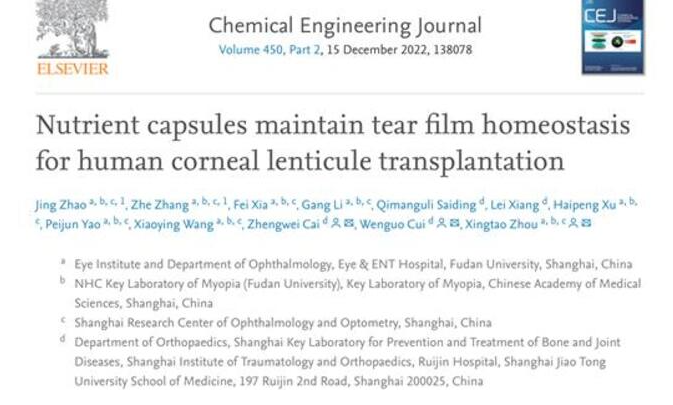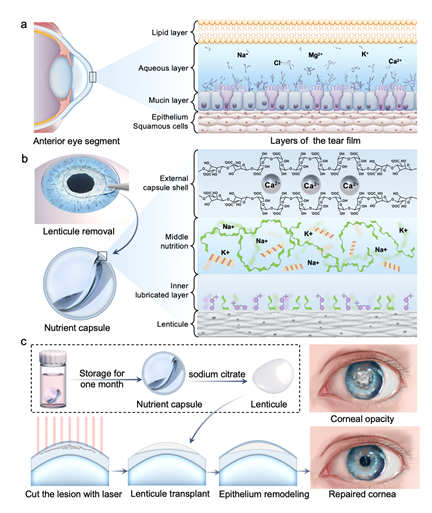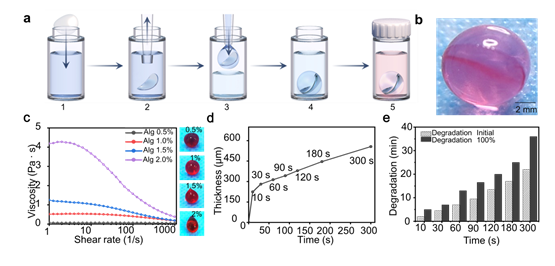
The ophthalmology, otolaryngology Hospital Affiliated to Fudan University recently heard good news: Professor Zhou Xingtao and his team have made significant progress in the research field of preservation and reuse of full femtosecond corneal stromal lens: by simulating the composition of human tears, they have successfully developed a new corneal tissue preservation medium - nutritional capsule, which has brought new breakthroughs in the treatment of corneal diseases such as keratoconus, corneal dystrophy and complications after corneal laser surgery. The research results were published online in the international top academic journal Chemical Engineering Journal. At present, this technology has been initially applied in clinic, and the full femtosecond lens preserved in the nutrition capsule has been successfully used in human corneal tissue transplantation.
It is reported that keratoconus and corneal dystrophy are intractable corneal diseases in the field of Ophthalmology, which make patients very painful. The former often occurs in teenagers, often leading to irregular astigmatism and high myopia, and both eyes have been affected successively; The latter is a hereditary corneal lesion, which develops gradually. Severe cases will lead to blindness, requiring corneal transplantation.
At present, there is a serious shortage of corneal donor materials in China, which is far from meeting the needs of patients who need corneal transplantation, and there are some problems after corneal transplantation, such as graft failure, graft rejection, astigmatism caused by sutures and so on. Doctors are facing great challenges in diagnosis and treatment.
Professor Zhou Xingtao's team has carried out myopia correction all femtosecond (smile) surgery since 2010. The number of operations has exceeded 170000, ranking first in the world. The source of smile corneal stromal lens is safe and reliable. Can these lenses be used to treat corneal diseases? Guided by clinical problems, Zhou Xingtao's team has been sharpening their swords for 12 years and making unremitting exploration. The team integrated the advantageous resources of multiple disciplines, carried out interdisciplinary joint research on the problem of corneal lens preservation and reuse, and used the previously abandoned corneal tissue lens in all femtosecond surgery to treat keratoconus, corneal dystrophy and complex ametropia, so that patients can regain their brightness.

Schematic diagram of the structure and preservation of the "amber" nutritional capsule and the reuse of the full femtosecond lens

Preparation and condition exploration of "amber" three-dimensional simulated nutritional capsule simulating human tears

Cases of corneal diseases treated by allogeneic transplantation with full femtosecond lens after preservation of nutrition capsule
Full femtosecond lens transplantation can be used to treat a variety of corneal diseases and alleviate the lack of corneal donor tissue. It has the advantages of small surgical trauma, no corneal suture, and reducing the economic burden of patients. However, corneal tissue preservation technology has some limitations, such as short preservation cycle, lack of maintenance of tissue structure and optics.
To this end, the team and Professor cuiwenguo of Ruijin Hospital Affiliated to the Medical College of Shanghai Jiaotong University cooperated to carry out research. Inspired by the composition of human natural tears, a new nutritional capsule simulating the steady state of human tears was constructed for stereoscopic preservation of corneal tissue: sodium alginate was rapidly diffused and coordinated with calcium ions to form the shell of the stereoscopic buffer capsule, simulating the lipid layer; Add sodium chondroitin sulfate, sodium hyaluronate, dextran and other substances as nutrient preservation solution, simulate the water-liquid layer, carry out nutrient supply, material metabolism and block pathogens through the capsule gap; The innermost layer is composed of chondroitin sulfate and the surface of the corneal lens to produce electrostatic effect, forming a lubricating layer.
The shape of the nutrition capsule is like transparent "amber", which can simulate the eye microenvironment in vivo to the greatest extent in vitro, provide three-dimensional "protection" for the corneal tissue stored therein, and play multiple roles such as physical barrier, nutrition supply and surface lubrication.
The results showed that the light transmittance, cell activity and collagen fiber density of corneal tissue after medium-term preservation of nutritional capsule were better than those of traditional preservation solution, and could basically maintain the characteristics of fresh tissue. The lens preserved in the nutrition capsule is safe and effective after human eye allograft for the treatment of corneal diseases. The implanted lens remains transparent without displacement and rejection. Three months after operation, the best corrected visual acuity of 70% of the operated eyes is increased by at least two lines compared with that before operation (visual acuity chart examination). The successful development of nutritional capsule provides a new safe and feasible strategy for the preservation and reuse of corneal tissue and other living organs.